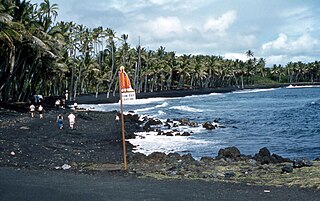 W
WIn 2008, two attempts were made by separate groups involved in the Hawaiian sovereignty movement to occupy ʻIolani Palace, the home of the last two monarchs of the Hawaiian Kingdom in downtown Honolulu in the U.S. state of Hawaii.
 W
WThe East Wood affair was an incident of piracy in early 1993 aboard the cargo ship East Wood, after Chinese illegal immigrants took control of the vessel before being taken back by her crew. More than 500 undocumented Chinese nationals were being transported in one of the largest efforts to smuggle Chinese into the United States in recent times.
 W
WAlfred Walter Francis Fuller was a British anthropologist and ethnographic collector, best known for his collection of over 6,800 items from the Pacific that is now held in the Field Museum in Chicago.
 W
WThe Hawaii Sesquicentennial half dollar was struck in 1928 by the United States Bureau of the Mint in honor of the 150th anniversary of Captain James Cook's landing in Hawaii, the first European to reach there. The coin depicts Captain Cook on the obverse and a Hawaiian chieftain on the reverse. Only 10,000 were struck for the public, making the coin rare and valuable.
 W
WThe Hawaiian Renaissance was the Hawaiian resurgence of a distinct cultural identity that draws upon traditional kānaka maoli culture, with a significant divergence from the tourism-based culture which Hawaiʻi was previously known for worldwide. The Hawaiian Renaissance has been pointed to as a global model for biocultural restoration and sustainability.
 W
WKaimū was a small town in the Puna District on Island of Hawaiʻi that was completely destroyed by an eruptive flow of lava from the Kūpaʻianahā vent of the Kīlauea volcano in 1990. In Hawaiian, kai mū means "gathering [at the] sea" as to watch surfing. The lava flow that destroyed Kaimū and nearby Kalapana erupted from the southeast rift zone of Kīlauea.
 W
WKalākaua was the last king and penultimate monarch of the Kingdom of Hawaiʻi. The inherited position of the kingdom's monarch became a legislatively elected office with Lunalilo. Upon Lunalilo's death, Kalākaua won election over his political opponent Queen Emma. He reigned from February 12, 1874, until his death in San Francisco, California, on January 20, 1891.
 W
WKalapana is a town and a region in the Puna District on the Island of Hawaiʻi in the Hawaiian Islands. The town was the original location of the Star of the Sea Painted Church.
 W
WKeaoua Kekua-o-kalani was a nephew of the king Kamehameha I, the chief from Hawaii Island who unified the Hawaiian islands.
 W
WCaptain James Cook's 1779 attempted kidnapping of Kalaniʻōpuʻu, the ruling chief of the island of Hawaii, and the decision to hold him in exchange for a stolen long boat (lifeboat) was the fatal error of Cook's final voyage, and ultimately led to his death.
 W
WIn Hawaii, the LGBT laws have been evolving for the past hundred years. In the pre-19th century, the influence of Polynesian culture led to a more open-minded state. After the first Christian missionaries began arriving in Hawaii, strict sodomy laws were enacted. Territory v. Bell (1958) was the last sodomy case argued in Hawaii. After the turn of the 20th century, LGBT issues began being taken to and decided by the Supreme Court. In 2013, Hawaii voted in favor of gay marriage, and marriage licenses began to be issued to LGBT couples.
 W
WLiliʻuokalani was the first queen regnant and last sovereign monarch of the Kingdom of Hawaiʻi. After King Kalākaua's brother and heir apparent Leleiohoku II died April 9, 1877, he proclaimed his sister Liliʻuokalani to be his successor. Upon his 1891 death, she ascended to the throne, ruling from January 29, 1891, until the overthrow of the Kingdom of Hawaiʻi on January 17, 1893.
 W
WLiliʻuokalani, the last monarch of Hawaii, died November 11, 1917. The royal standard (flag) was raised over her home at Washington Place to signal to the public that she was deceased. Under military guard, her body was moved at midnight for embalming. After the traditional Hawaiian mourning of chanting and wailing, the public was allowed to view her body covered only by a shroud. Her state funeral was held in the throne room of Iolani Palace, on November 18, 1917, followed by her funeral procession to the Royal Royal Mausoleum of Mauna ʻAla. An estimated 1,500 adults and children were in the funeral procession.
 W
WThe Oahu sugar strike of 1920 was a multiracial strike in Hawaii of two unions, the Filipino American Filipino Labor Union and the Japanese American Federation of Japanese Labor. The labor action involved 8,300 sugar plantation field workers out on strike from January to July 1920.
 W
W W
WThe 2009 USS Port Royal grounding was a ship grounding by the United States Navy guided missile cruiser Port Royal off Oahu, Hawaii on 5 February 2009. The ship ran aground on a coral reef, damaging both the ship and the reef. The incident received wide press coverage in Hawaii, in part because of the damage caused to a sensitive coral environment, and also because the stranded ship was within sight of Honolulu off the airport.
 W
WSpanish immigration to Hawaii began in 1907 when the Hawaiian government and the Hawaiian Sugar Planters' Association (HSPA) decided to supplement their ongoing importation of Portuguese workers to Hawaii with workers recruited from Spain. Importation of Spanish laborers, along with their families, continued until 1913, at which time more than 9,000 Spanish immigrants had been brought in, most recruited to work primarily on the Hawaiian sugarcane plantations.